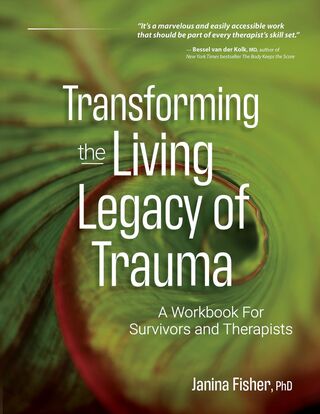Trauma
Transforming the Living Legacy of Trauma
The Book Brigade talks to writer Janina Fisher.
Posted March 31, 2021 Reviewed by Jessica Schrader

For some people, the scars of trauma run deep in the psyche, affecting the course of everyday life. Often, to protect against the possibility of repeated harm, the body and the mind become hyperalert to danger, even seeing danger may not exist. In a sense, the past event of trauma is never past. The reactions can be baffling to survivors themselves and troubling in their own right. From combat to sexual abuse, millions are subjected to trauma each year.
What do you define as trauma?
I use a particular definition of trauma that comes from Karen Saakvitne: Trauma can be a single event, a series of events, or a set of enduring conditions that overwhelm the individual’s capacity to tolerate or even stay fully present and that are perceived by the individual as a threat to life, sanity or bodily integrity. “Developmental trauma,” a new very popular term these days, refers to a set of enduring conditions in childhood in which abusive events cause a fear of threat to life, sanity, or bodily integrity by the child’s attachment figures.
There is a large and growing bookshelf on trauma. What prompted you to add to it?
For years, I have been asked to recommend basic books on trauma geared to trauma survivors that would help them make sense of what has happened and how it has affected them. There have not been excellent books I could recommend, so I saw there was a need. At the same time, I was receiving emails from survivors thanking me for my publication, “Psychoeducational Aids for Treating Psychological Trauma” and telling me how much it meant to them to have their symptoms and issues normalized. In addition, I meet thousands of therapists from around the world every year, and I could see that, although the field had transformed dramatically since its inception, therapeutic practice had not. Most therapists were still treating the events, not their effects.
What do you believe you are adding to it?
The feedback from both therapists and survivors has been very validating. I had a three-fold purpose in writing: to provide that book that could explain modern trauma theory to trauma survivors in simple terms, to support survivors by normalizing and making sense of their responses, and to support therapists by updating their understanding of trauma. What I hear back from readers is that I am meeting those needs. We have a very large body of literature for professionals on trauma but many fewer books for the trauma survivor. It is crucial that we get away from the emphasis on the traumatic events when the culprit is not the event but the enduring effects it causes.
Why do you believe trauma is such an important topic these days?
We are living in traumatic times! Beginning with 9/11, it became clearer to the entire world that traumatic events affect us all. Trauma is not just caused by child abuse or domestic violence or war. It is caused by accidents, natural disasters, political terrorism, and even diseases. COVID is a traumatic threat to our lives right now. Domestic terrorism is a traumatic threat. Racism is a traumatic threat and has been for hundreds of years.
In addition, estimates are that 70 percent of all psychiatric inpatients have histories of trauma and 30-40 percent of all outpatients. Very few of us get through life without exposure to trauma, making it all the more important that we are ready to help people with the effects of the events they have experienced. Telling the story of what happened is not nearly sufficient to heal trauma. We have to be able to work with the somatic effects, the emotional effects, and the relational effects, including the relationship to one’s self.
Is there more trauma occurring in the world today than in times past or are people more aware of it or vulnerable to it?
This is a traumatic time in human history between COVID and the increasing power and influence of white supremacist and antisemitic groups.
What is the living legacy of trauma?
The living legacy of trauma describes the way in which past traumatic events do not just leave scars upon victims that clearly have been inflicted in the past. Trauma leaves behind a living legacy of emotions (fear, shame, anger) and physical responses (startling, impulses to run or hide or fight, even against one’s own body) that continue to be stimulated by the subtlest of cues in people’s day to day lives. Trauma doesn’t feel like a past event when its effects are constantly stimulated by normal everyday things.
How does trauma affect the brain and body?
When we perceive threat or danger, the brain and body mobilize to defend. A rush of adrenaline increases heart rate and respiration to speed oxygen to muscle tissue to give our bodies the energy to flee or fight. Very importantly, the prefrontal cortex, the thinking and verbal brain, is inhibited to enable instinctive responding without overthinking. Then, once we have survived, our parasympathetic nervous systems are activated to help us recover—or, if it’s not safe to defend ourselves, to initiate total submission responses that drain our energy and stop our ability to take action.
That cycle does not stop once we’ve recovered, however. It continues to be stimulated by threat cues, including such cues as the time of day, day of the week, season, weather conditions, as well as common experiences such as other people frowning or not responding, failing to understand, making us wait, disappointing or hurting our feelings. Each time we encounter a trauma-related trigger, the emergency stress response system reacts with the same cycle of fight, flight, or submission responses.
How does trauma negatively affect people’s lives?
Traumatized individuals then live at the mercy of triggers and triggering. Since their trauma responses continue to be activated on a daily basis, they don’t feel safe. If their minds and bodies are still fighting the threat, they suffer from problems with anger (at themselves as well as others), aggression, or self-inflicted violence in the form of self-harm and suicide attempts.
If their flight responses continue to be triggered, they experience impulses to distance even from those they love, struggle with commitment, or they engage in addictive or eating disordered behavior that numbs and quiets the fight and flight responses or stimulates energy so they feel more powerful. Depression, anxiety, chronic pain, OCD, borderline personality disorder, and even schizophrenia are all highly associated with a history of trauma.
To what degree are people aware that the legacy is influencing their lives?
Very few people are aware of the connection between their symptoms and difficulties to the traumatic events of their past. In fact, they usually expect themselves to be over it by this point in their lives. Worst of all, many survivors believe that the symptoms are signs that they are crazy. Not knowing that they are still being impacted by the living legacy of the events, they tend to blame themselves or to blame those around them—or a combination of both. So often, they believe, “It was all my fault,” “There is something wrong with me,” or “I don’t deserve to be treated well.” Others believe, “People just want to use me,” “My spouse doesn’t care about me,” “No one respects me.”
What does recovering from trauma entail?
Recovery from trauma is much more than remembering what happened and disclosing it to a witness, as so many therapists were taught to believe in the 90s. We now know that recovery includes waking up the prefrontal cortex with psychoeducational and mindfulness techniques so that the body and nervous system become calmer. It includes learning to recognize the implicit nonverbal feeling and body memories as memory, rather than as signs of alarm, to work with the bodily and nervous system effects of the trauma, and to understand impulsive or self-destructive behavior as driven by trauma responses. Last but certainly not least, recovery must include acceptance of what has happened and acceptance of one’s self—letting go of the shame and beliefs in unworthiness and welcoming the child we all once were as young and innocent, hurt rather than damaged.
What is the most surprising thing about trauma you have discovered in your work?
The most surprising thing I’ve discovered about trauma in the 30 years I’ve been in the field is what an uplifting and positive experience it is to work with trauma. If we don’t get lost in the horrific details of the events or their gravity and instead celebrate how ingeniously our clients survived, it is a very hopeful field. I am always inspired by my clients, by how they adapted even as tiny children to the maladaptive world into which they born, and by how they learn to be here now and even blossom in a life beyond trauma.
If you had to limit yourself to one item, what one idea or insight would you like readers to get from this book?
The one idea I most want the reader to take away is that every symptom is a badge of courage that tells part of the story of how that individual survived. Depression and hopelessness make us smaller, slower, and less visible. Anxiety keeps us alarmed and on guard. Shame robs us of speech, and self-blame keeps us quiet and compliant. Drugs and alcohol, self-harm, restricting food, or binging all offer relief from overwhelming and incapacitating symptoms—until they become severe and life-threatening issues in their own right.
To understand one’s symptoms as an act of courage and ingenuity reduces shame and increases the hope that if they were ingenious enough to survive, there is hope for the future.
About THE AUTHOR SPEAKS: Selected authors, in their own words, reveal the story behind the story. Authors are featured thanks to promotional placement by their publishing houses.
To purchase this book, visit: Transforming the Living Legacy of Trauma.





